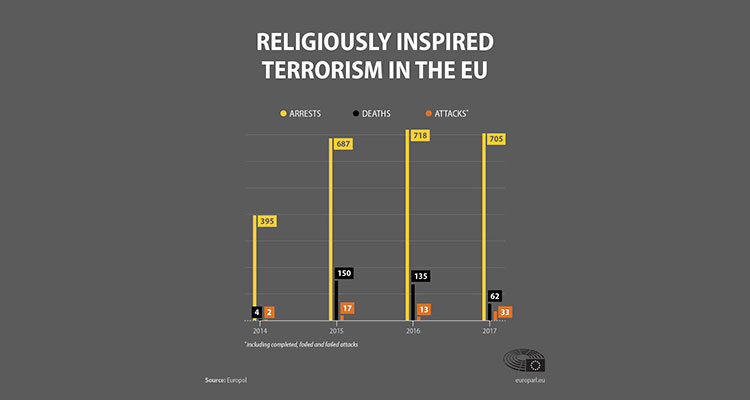The terrorist threat has changed in nature in recent years. Check our graph to see the evolution of attacks, deaths and arrests since 2014.
In recent years there has been an increase in terrorist threats and attacks, beginning in 2015 with the killings at the Charlie Hebdo magazine office in Paris.
Terrorist attacks in numbers
In 2017, 62 people were killed in 33 religiously inspired terrorist attacks in the EU, compared to 135 deaths in 13 attacks in 2016, according to Europol figures. In both years 10 attacks were considered as “completed” by national governments, because they achieved their target. In 2017 many more attacks were foiled or failed compared to 2016: 23 in 2017 compared to three the year before.
In 2015, the number of deaths caused by this kind of attack reached a peak of 150, sharply up from four in 2014. In 2017 the attacks were much less lethal.
Presenting the EU’s terrorism situation and trend report 2018 to Parliament’s civil liberties committee on 20 June, Manuel Navarrete, head of Europol’s European Counter Terrorism Centre, said, “The attacks are less sophisticated, there are more, but fortunately they produce less victims.”
Situation in 2017
Ten of the 33 attacks were assessed as “completed” in 2017, while 12 failed to reach their objectives in full and 11 were foiled, mostly in France and the UK.
That year 62 people died: UK (35), Spain (16), Sweden (5), France (3), Finland (2) and Germany (1). A further 819 people were injured.
A total of 705 people were arrested in 18 EU countries (373 in France) on suspicion of involvement in jihadist terrorist activities.
EU cooperation
The reinforced cooperation between EU countries, sharing information, has helped to prevent attacks, stop them or limit their impact, according to Navarrete. “The plots are identified earlier because the tools for intelligence and police are used in a more accurate way.” He added: “We are preventing [attacks] and mitigating the number of people that are killed or injured.”.
Potential threats
However, despite the success of the common approach, it remains important to stay vigilant. Navarrete said: “One of the most significant threats is people that have been arrested for their connection with the foreign fighter phenomenon and will be released shortly.”
Most attacks are now perpetrated by home-grown terrorist radicalised in the European country where they are living, without having necessarily travelled to conflict zones such as Syria or Iraq, he said.
“There are still people returning from conflict zones like Iraq, but the figures were very low in 2017.”
No systematic use of migration routes by terrorists
Some people have been concerned about the risk posed by migrants trying to enter Europe. Navarrette said: “We haven´t seen a systematic use of these routes by terrorists.” However, he added that Europol had identified “some terrorists” who try to use migration routes to enter the EU and that is why it has reinforced its cooperation with countries such as Greece and Italy and remains “vigilant”.



